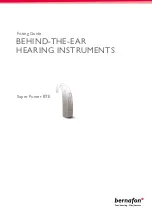
IFU00021vH
9
cease, become reduced or become intermittent. Perform the following troubleshooting steps to assess
Lens function:
a. Inspect the ear canal and Lens
.
If the Lens is blocked by debris, carefully clean the ear canal. If
removal or reinsertion is required, follow
Lens Removal
and
Cleaning and Preparing Lens for
Reinsertion
instructions above.
b. Verify functionality of the Lens on the patient’s ear using the Earlens Light Pen. Please read and
follow the precautions and procedures found in the Earlens Light Pen Instructions for Use. If
removal or reinsertion of the Lens is required, follow
Lens Removal
and
Cleaning and Preparing
Lens for Reinsertion
instructions above.
c. Inspect the position of the Lens on ear. If the perimeter platform does not appear to be in contact
with the wall of the ear canal, the Lens may be displaced.
I.
In the event of displacement of the Lens, remove the device per
Lens Removal
instructions and replace following the
Cleaning and Preparing Lens for Reinsertion
operating instructions.
d. Inspect the appearance of the Lens on ear. If the Lens appears damaged or abnormal, remove
using the
Lens Removal
instructions and contact Earlens.
e. If there is a suspected performance issue with the Lens that otherwise appears fine visually (e.g.
significant elevation of system Light Calibration), remove the device per
Lens Removal
instructions and replace following the
Cleaning and Preparing Lens for Reinsertion
operating
instructions. Once Lens is replaced assess if the suspected performance issue is resolved (e.g.
system Light Calibration is no longer elevated).
If after performing the troubleshooting steps listed above, the Lens still does not function, remove it using
the
Lens Removal
operating instructions and contact Earlens.
9.6. Care & Maintenance
a. Store the Earlens Hearing Aid in a clean, dry location out of direct sunlight.
b. The expected life of the Lens is one year. As for any patient with a hearing assist device, it is
recommended that the patient return annually to their hearing professional(s) to monitor their
audiologic and otologic status.
10. Operating Specifications
•
For technical details about the Earlens Light Driven Hearing Aid and compliance to applicable
standards, please consult the Hearing Professional Instructions for Use.
•
Certain components of the Earlens Hearing Aid, including the Processor and the Light Tip are
classified as a Type BF applied parts as described in the international standard IEC 60601-1:2005,
Medical Electrical Equipment-Part 1:General Requirements for Basic Safety and Essential
Performance.
•
Expected service life of the Earlens Hearing Aid include:
o
Processor and Charger- three years
o
Light Tip- one year
o
Lens- one year
•
The Earlens Hearing Aid is designed for continuous use.
•
The Processor is not designed to prevent the ingress of water.
10.1 Power Requirements
Battery Charger Input
100-240 VAC, 50-60Hz, 0.2A
Battery Charger Output
5.0 VDC, 1.0A
























